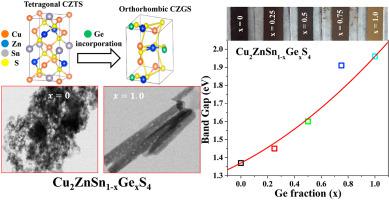当前位置:
X-MOL 学术
›
Mater. Chem. Phys.
›
论文详情
Our official English website, www.x-mol.net, welcomes your
feedback! (Note: you will need to create a separate account there.)
Facile solvothermal synthesis of Cu2ZnSn1-xGexS4 nanocrystals: Effect of Ge content on optical and electrical properties
Materials Chemistry and Physics ( IF 4.3 ) Pub Date : 2021-01-01 , DOI: 10.1016/j.matchemphys.2020.123764 D. Mora-Herrera , Mou Pal , F. Paraguay-Delgado
Materials Chemistry and Physics ( IF 4.3 ) Pub Date : 2021-01-01 , DOI: 10.1016/j.matchemphys.2020.123764 D. Mora-Herrera , Mou Pal , F. Paraguay-Delgado

|
Abstract Controlled incorporation of extrinsic elements in Cu2ZnSnS4 (CZTS) matrix has been proven to be a successful approach to improve the device efficiency of kesterite solar cells. In this paper, we have reported the synthesis of polycrystalline Cu2ZnSn1-xGexS4 (CZTGS) nanocrystals (NCs) ( 0 ≤ x ≤ 1 ; x = [ Ge ] / [ Sn + Ge ] ) by facile and cost-effective solvothermal method. The powder samples were annealed under inert atmosphere in presence of sulfur powder to improve crystallinity. The effect of Ge alloying on structural, morphological, compositional, optical and electrical properties was studied using different characterization tools. X-ray diffraction analysis revealed the structural evolution of tetragonal Cu2ZnSnS4 (CZTS) to orthorhombic Cu2ZnGeS4 (CZGS) with the increase of Ge/Sn ratio. Characteristic Raman peaks were shifted to higher frequency with increasing Ge concentration. The transition of quasi-spherical morphology for kesterite CZTS into rod-like shape for orthorhombic CZGS was evidenced by Transmission electron microscopy. The band gap of resulting CZTGS NCs were found to increase from 1.37 to 1.96 eV by increasing Ge content. The doctor-blade printed CZTGS films were p-type. By increasing Ge concentration, carrier concentration was increased gradually, while electrical resistivity and hole mobility were found to decrease. The electrical properties suggest that a relatively low Ge incorporation might be beneficial for their application as photoabsorber in photovoltaic devices.
中文翻译:

Cu2ZnSn1-xGexS4 纳米晶体的简便溶剂热合成:Ge 含量对光学和电学性能的影响
摘要 在 Cu2ZnSnS4 (CZTS) 基质中受控掺入外来元素已被证明是提高锌黄铜矿太阳能电池器件效率的成功方法。在本文中,我们报道了多晶 Cu2ZnSn1-xGexS4 (CZTGS) 纳米晶体 (NCs) (0 ≤ x ≤ 1 ; x = [ Ge ] / [ Sn + Ge ] ) 的合成方法,该方法简便且经济高效。粉末样品在惰性气氛下在硫粉存在下退火以提高结晶度。使用不同的表征工具研究了 Ge 合金化对结构、形态、成分、光学和电学性能的影响。X 射线衍射分析揭示了随着 Ge/Sn 比的增加,四方 Cu2ZnSnS4 (CZTS) 到正交 Cu2ZnGeS4 (CZGS) 的结构演变。随着 Ge 浓度的增加,特征拉曼峰转移到更高的频率。透射电子显微镜证实了黄铜矿 CZTS 的准球形形态转变为正交 CZGS 的棒状形状。通过增加 Ge 含量,发现所得 CZTGS NCs 的带隙从 1.37 eV 增加到 1.96 eV。刮刀印刷的 CZTGS 薄膜是 p 型的。随着Ge浓度的增加,载流子浓度逐渐增加,而电阻率和空穴迁移率降低。电学特性表明,相对较低的 Ge 掺入量可能有利于它们在光伏器件中作为光吸收剂的应用。透射电子显微镜证实了黄铜矿 CZTS 的准球形形态转变为正交 CZGS 的棒状形状。通过增加 Ge 含量,发现所得 CZTGS NCs 的带隙从 1.37 eV 增加到 1.96 eV。刮刀印刷的 CZTGS 薄膜是 p 型的。随着Ge浓度的增加,载流子浓度逐渐增加,而电阻率和空穴迁移率降低。电学特性表明,相对较低的 Ge 掺入量可能有利于它们在光伏器件中作为光吸收剂的应用。透射电子显微镜证实了黄铜矿 CZTS 的准球形形态转变为正交 CZGS 的棒状形状。通过增加 Ge 含量,发现所得 CZTGS NCs 的带隙从 1.37 eV 增加到 1.96 eV。刮刀印刷的 CZTGS 薄膜是 p 型的。随着Ge浓度的增加,载流子浓度逐渐增加,而电阻率和空穴迁移率降低。电学特性表明,相对较低的 Ge 掺入量可能有利于它们在光伏器件中作为光吸收剂的应用。随着Ge浓度的增加,载流子浓度逐渐增加,而电阻率和空穴迁移率降低。电学特性表明,相对较低的 Ge 掺入量可能有利于它们在光伏器件中作为光吸收剂的应用。随着Ge浓度的增加,载流子浓度逐渐增加,而电阻率和空穴迁移率降低。电学特性表明,相对较低的 Ge 掺入量可能有利于它们在光伏器件中作为光吸收剂的应用。
更新日期:2021-01-01
中文翻译:

Cu2ZnSn1-xGexS4 纳米晶体的简便溶剂热合成:Ge 含量对光学和电学性能的影响
摘要 在 Cu2ZnSnS4 (CZTS) 基质中受控掺入外来元素已被证明是提高锌黄铜矿太阳能电池器件效率的成功方法。在本文中,我们报道了多晶 Cu2ZnSn1-xGexS4 (CZTGS) 纳米晶体 (NCs) (0 ≤ x ≤ 1 ; x = [ Ge ] / [ Sn + Ge ] ) 的合成方法,该方法简便且经济高效。粉末样品在惰性气氛下在硫粉存在下退火以提高结晶度。使用不同的表征工具研究了 Ge 合金化对结构、形态、成分、光学和电学性能的影响。X 射线衍射分析揭示了随着 Ge/Sn 比的增加,四方 Cu2ZnSnS4 (CZTS) 到正交 Cu2ZnGeS4 (CZGS) 的结构演变。随着 Ge 浓度的增加,特征拉曼峰转移到更高的频率。透射电子显微镜证实了黄铜矿 CZTS 的准球形形态转变为正交 CZGS 的棒状形状。通过增加 Ge 含量,发现所得 CZTGS NCs 的带隙从 1.37 eV 增加到 1.96 eV。刮刀印刷的 CZTGS 薄膜是 p 型的。随着Ge浓度的增加,载流子浓度逐渐增加,而电阻率和空穴迁移率降低。电学特性表明,相对较低的 Ge 掺入量可能有利于它们在光伏器件中作为光吸收剂的应用。透射电子显微镜证实了黄铜矿 CZTS 的准球形形态转变为正交 CZGS 的棒状形状。通过增加 Ge 含量,发现所得 CZTGS NCs 的带隙从 1.37 eV 增加到 1.96 eV。刮刀印刷的 CZTGS 薄膜是 p 型的。随着Ge浓度的增加,载流子浓度逐渐增加,而电阻率和空穴迁移率降低。电学特性表明,相对较低的 Ge 掺入量可能有利于它们在光伏器件中作为光吸收剂的应用。透射电子显微镜证实了黄铜矿 CZTS 的准球形形态转变为正交 CZGS 的棒状形状。通过增加 Ge 含量,发现所得 CZTGS NCs 的带隙从 1.37 eV 增加到 1.96 eV。刮刀印刷的 CZTGS 薄膜是 p 型的。随着Ge浓度的增加,载流子浓度逐渐增加,而电阻率和空穴迁移率降低。电学特性表明,相对较低的 Ge 掺入量可能有利于它们在光伏器件中作为光吸收剂的应用。随着Ge浓度的增加,载流子浓度逐渐增加,而电阻率和空穴迁移率降低。电学特性表明,相对较低的 Ge 掺入量可能有利于它们在光伏器件中作为光吸收剂的应用。随着Ge浓度的增加,载流子浓度逐渐增加,而电阻率和空穴迁移率降低。电学特性表明,相对较低的 Ge 掺入量可能有利于它们在光伏器件中作为光吸收剂的应用。











































 京公网安备 11010802027423号
京公网安备 11010802027423号